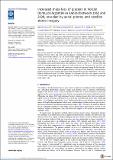Files in this item
Increased mass loss of glaciers in Volcán Domuyo (Argentinian Andes) between 1962 and 2020, revealed by aerial photos and satellite stereo imagery
Item metadata
| dc.contributor.author | Falaschi, Daniel | |
| dc.contributor.author | Berthier, Etienne | |
| dc.contributor.author | Belart, Joaquín M. C. | |
| dc.contributor.author | Bravo, Claudio | |
| dc.contributor.author | Castro, Mariano | |
| dc.contributor.author | Durand, Marcelo | |
| dc.contributor.author | Villalba, Ricardo | |
| dc.date.accessioned | 2022-07-08T09:30:10Z | |
| dc.date.available | 2022-07-08T09:30:10Z | |
| dc.date.issued | 2023-02-01 | |
| dc.identifier | 280400762 | |
| dc.identifier | 25a30ec6-9291-439b-83f3-1c31d0c1564b | |
| dc.identifier | 000821339000001 | |
| dc.identifier | 85148750662 | |
| dc.identifier.citation | Falaschi , D , Berthier , E , Belart , J M C , Bravo , C , Castro , M , Durand , M & Villalba , R 2023 , ' Increased mass loss of glaciers in Volcán Domuyo (Argentinian Andes) between 1962 and 2020, revealed by aerial photos and satellite stereo imagery ' , Journal of Glaciology , vol. 69 , no. 273 , pp. 40-56 . https://doi.org/10.1017/jog.2022.43 | en |
| dc.identifier.issn | 0022-1430 | |
| dc.identifier.other | RIS: urn:AB4324CA66BA404FB547CC8560A7A499 | |
| dc.identifier.uri | https://hdl.handle.net/10023/25634 | |
| dc.description | Funding: The authors acknowledge funding by the Agencia Nacional de Promoción Científica y Técnica (Grant PICT 2007-0379 and PICT 2016-1282) and CONICET (Grant PIP 11220110100200). EB acknowledges support from the French Space Agency (CNES). | en |
| dc.description.abstract | We present geodetic mass-balance estimates for ten glaciers (22.6 ± 1.1 km2) around Volcán Domuyo between 1962 and 2020 (and 46 glaciers covering 29 ± 1.5 km2 between 1984 and 2020), derived from airborne, ASTER and Pléiades imagery. Overall, we find a slightly negative mass balance (−0.15 ± 0.09 m w.e. a–1) for the entire 1962–2020 time span. A closer inspection of sub-periods reveals, however, an increasingly negative mass balance with time. The Domuyo glaciers shifted from a moderately positive mass balance of +0.28 ± 0.13 m w.e. a–1 between 1962 and 1984, to a strongly negative mass balance of −0.99 ± 0.19 m w.e. a–1 between 2012 and 2020. An increase in summer temperatures and a decrease in winter precipitation during the last four decades are likely drivers of the observed glacier changes. We support this finding by implementing a minimal glacier model, relying solely on monthly precipitation and air temperatures. The mass-balance evolution detected in Volcán Domuyo is consistent with other sites spread across the Central Andes, suggesting rapidly increasing glacier wastage impacts are occurring at a geographically wider scale. | |
| dc.format.extent | 17 | |
| dc.format.extent | 11877972 | |
| dc.language.iso | eng | |
| dc.relation.ispartof | Journal of Glaciology | en |
| dc.subject | Glacier mass balance | en |
| dc.subject | Glacier modelling | en |
| dc.subject | Glacier volume | en |
| dc.subject | Mountain glaciers | en |
| dc.subject | GB Physical geography | en |
| dc.subject | 3rd-DAS | en |
| dc.subject | MCC | en |
| dc.subject.lcc | GB | en |
| dc.title | Increased mass loss of glaciers in Volcán Domuyo (Argentinian Andes) between 1962 and 2020, revealed by aerial photos and satellite stereo imagery | en |
| dc.type | Journal article | en |
| dc.contributor.institution | University of St Andrews. School of Geography & Sustainable Development | en |
| dc.identifier.doi | 10.1017/jog.2022.43 | |
| dc.description.status | Peer reviewed | en |
This item appears in the following Collection(s)
Items in the St Andrews Research Repository are protected by copyright, with all rights reserved, unless otherwise indicated.

